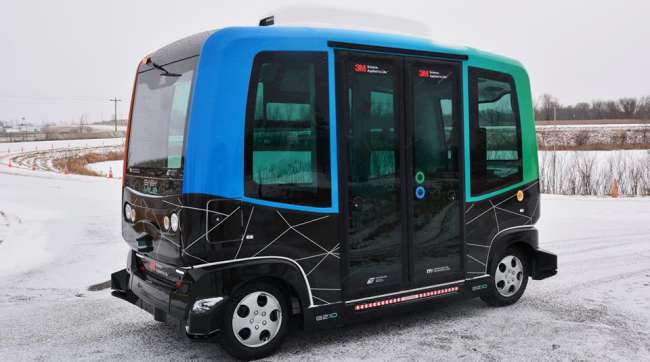Minnesota Safety Officials Look to Driverless Vehicles to Reduce Fatalities

The late snowfalls in Minnesota this year might help autonomous vehicle developers save lives.
Minnesota Gov. Mark Dayton issued an executive order in March establishing a council to study use of automated and connected vehicles in Minnesota. Jay Hietpas, director of that council, was in Rochester on May 2 at the Southeast Minnesota Toward Zero Deaths workshop, where he presented updates and recent tests of MinnEride — the state’s first driverless shuttle. MinnEride has no operational steering wheel or pedals.
Most autonomous vehicle development tests have taken place in southern parts of the United States, Hietpas told the crowd at the International Events Center.
RELATED: Minnesota speeds up planning for self-driving cars
“We have not seen a lot of winter weather-condition testing,” he said. “So that’s a huge concern moving forward.”
In MinnEride’s first encounter with blowing snow last month, its sensors brought the vehicle to a halt, Hietpas said in an interview after his presentation. Off-site software developers monitoring the situation were able to program the vehicle to discern the blowing snow from a solid obstacle.
“The first day we had it out there in a snowstorm, it just stopped,” Heitpas said. “After a few days, it slowed down but recognized it wasn’t a pedestrian or bicyclist.”
MinnEride made an appearance in Rochester on March 22. The driverless shuttle took 267 riders on a short jaunt around Peace Plaza downtown, Hietpas said.
IBM engineers in Rochester are helping develop software for riders of automated buses. Matt Paschal, IBM electrical engineer, described how he and his team are designing ways for people of different abilities to use and interact with a driverless shuttle. As software adapts to new situations, shuttles using the same software and network all will be updated, Paschal said.
“That information will be shared with all vehicles in the fleet,” he said.
The Southeast Minnesota Toward Zero Deaths workshop was the 14th annual event. Hietpas said the initiative has helped reduced statewide traffic fatalities by about 45% over 15 years. However, pedestrian fatalities have remained steady in that time period, he added. Automated vehicles could help reduce pedestrian fatalities, he said.
AVs eliminate inattentiveness, and that should help reduce pedestrian fatalities,” he said.
However, Hietpas and Paschal noted in their presentations autonomous vehicles made headlines when a pedestrian in Arizona was killed in March by a vehicle in automated driving mode. Both said they couldn’t comment on that situation since they weren’t familiar with the software the vehicle was using at the time of the incident.
“We’ll learn much more once the [National Transportation Safety Board] completes its investigation,” Hietpas said.
Snow isn’t the only obstacle for widespread use and adoption of driverless vehicles, Hietpas said. How these vehicles interact with law enforcement, who is qualified to be a human driver, if needed, and how they are recognized legally and by insurance companies are just a few of the questions that need to be answered before the vehicles are on the road for more than development and testing, he added. Not every company developing them is going in the same direction.
“Each of these companies have their own little niche,” he said. “It’s hard to see right now when these questions will be answered and how.”
Distributed by Tribune Content Agency, LLC




